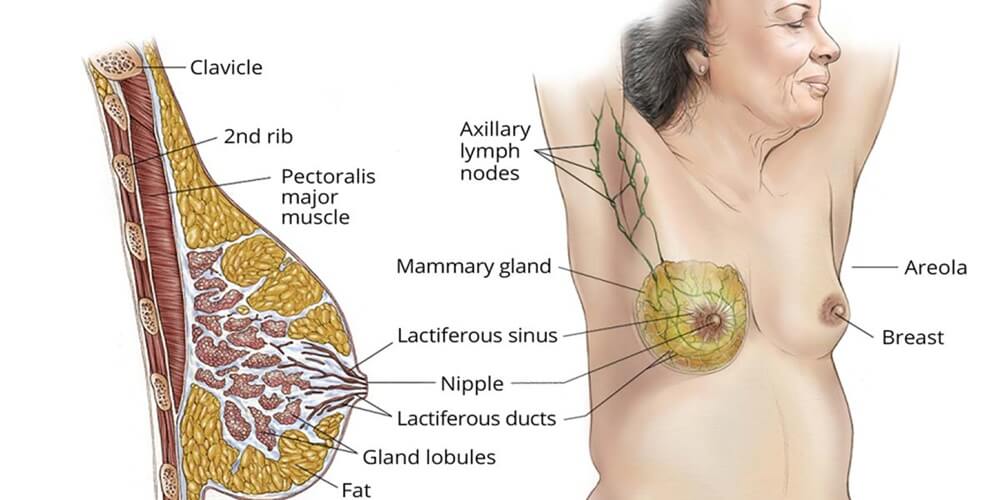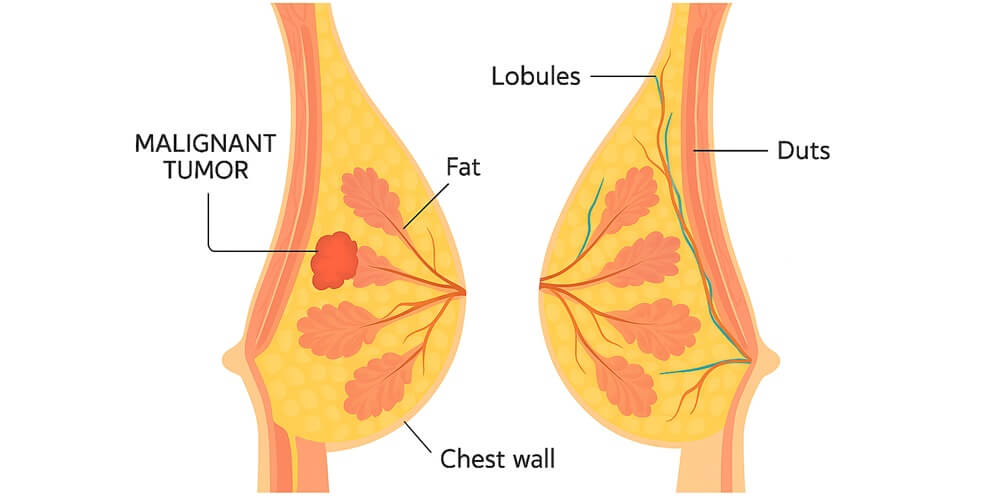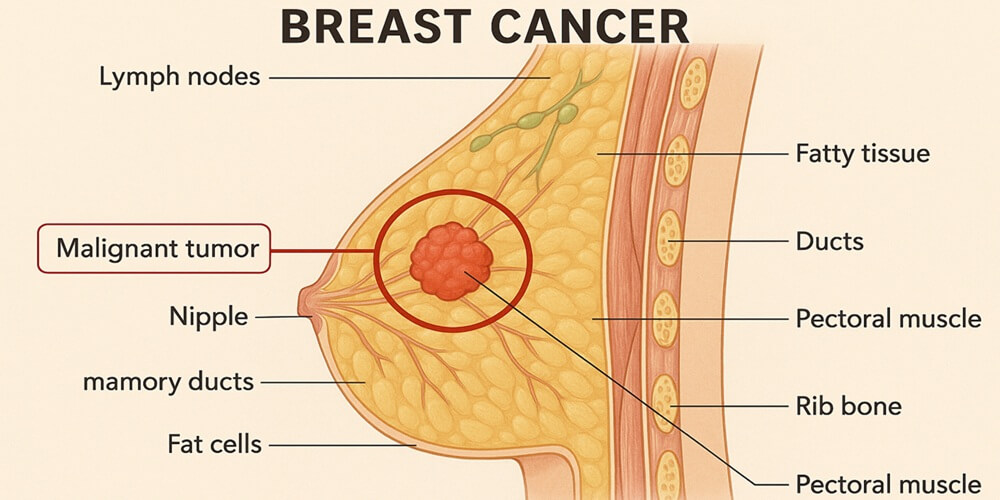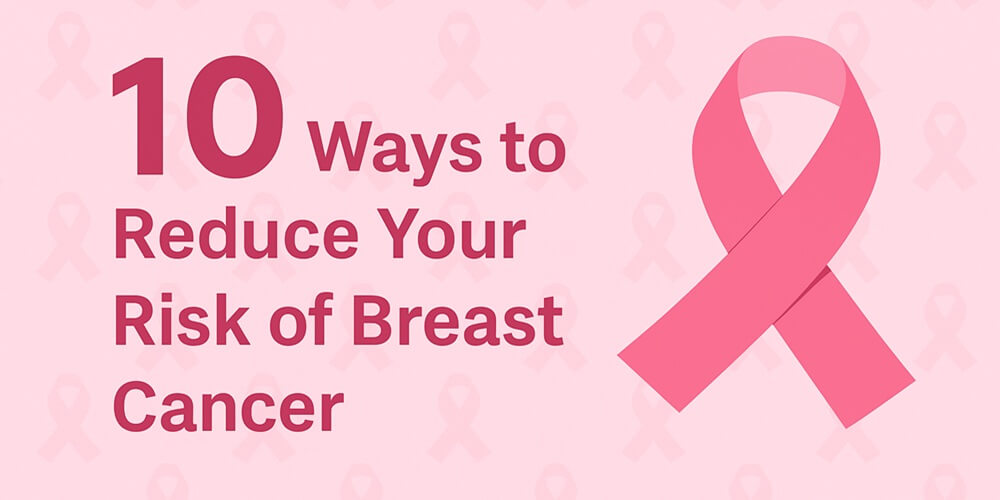Home » 10 Ways to Lower Your Risk of Breast Cancer

Breast cancer is a female health problem that draws great public interest, as failing to identify this problem in a timely manner can lead to illness and death of the entire community. Breast cancer is the second most frequent cancer in women in the globe after skin cancer. The most frequent reason for cancer death in women in underdeveloped nations is breast cancer, and in the majority of developed nations, the second most frequent. There are estimated 1,368,000 new cases in 2010 and closer to 459,000 deaths from breast cancer in the world. However, breast cancer incidence and mortality rates vary regionally.
In developed countries, the age-standardized incidence rises steeply with increasing age, while the age-standardized breast cancer mortality rates begin to rise after several decades but plateau at older ages, typically due to high proportions of cause-specific mortality from other competing causes.

Breast cancer is a malignant tumor that grows in the breast. The breast is made up of lobes, which are divided into small parts called lobules. They are the ones that secrete milk. Milk is carried by ducts to the nipple. A breast is made up of lymph vessels and lymph nodes, which are part of the body’s immune system. They reside in the body and are connected through lymph vessels. Breast cancer can start in any part of the breast. Most breast cancers start in the lobules or ducts. If the breast cancer has spread to the lymph nodes, it can spread to other areas of the body via the lymph vessels. It can spread through the bloodstream, too.
Category | Details |
Lifetime Risk (Women) | 1 in 8 women will develop breast cancer during their lifetime |
Mortality Risk (Women) | 1 in 38 women will die from breast cancer |
Annual New Diagnoses (Women) | Estimated 287,850 new invasive breast cancer cases |
Annual Deaths (Women) | Approximately 43,250 deaths |
Racial Disparities | – Black women have a higher mortality rate- White women are more often diagnosed |
Male Breast Cancer Cases | Estimated 2,710 new cases per year |
Male Breast Cancer Deaths | Approximately 530 deaths per year |
5-Year Survival Rate (Women) | 91% of women survive at least 5 years after diagnosis |
Trend in Mortality | Death rates have declined since 1989 |
Long-Term Effects of Treatment | High-risk women may experience:- Recurrence of breast cancer- Cardiovascular disease- Illnesses from hormone therapy, surgery, chemo, radiotherapy |
Breast cancer is a multifactor disease that can be conditioned by the development of prevention actions that can be classified in primary prevention, which acts in the decrease of incidence of the disease and its most important part is the change of risk factors, secondary prevention with the goal of the detection of the disease in the early phases and the most important are the early diagnosis and treatment; and tertiary prevention with the goal of avoiding complications and recurrences of the disease, reducing mortality and improving the quality of life of the patients. The personalized prevention strategies for breast cancer are pharmacologic prevention using selective estrogen receptor modulators, aromatase inhibitor use, surgical risk-reducing interventions such as mastectomy and oophorectomy and lifestyle modifications reducing the risk through mechanisms in operation of nature.
The aim of these different strategies is to reduce breast cancer risk in mutation carriers with a very high risk of hereditary breast cancer. Pharmacological and surgical prevention strategies have been evaluated through decision analysis based on data from large prospective international cohorts that have sought to estimate the magnitude of risk reduction due to different strategies based on data from these series of high-risk women or model predictions based on the principles of genetic epidemiology. These women are also often treated prophylactically with tamoxifen, a selective estrogen receptor modulator, or an aromatase inhibitor to reduce the risk of breast cancer, and oophorectomy is performed to minimize the risk of ovarian cancer, but these interventions also reduce the risk of breast cancer. The goal of establishing these prevention strategies is to encourage these mutation carriers or to modify their risk by natural mechanisms.

The first thing we all would love to know is how to prevent breast cancer. Is prevention really possible? Well, maybe. We are accustomed to think that medical research has discovered the cause, how, and when breast cancer occurs, and hence some way to prevent its appearance. For some no, for at least 80% of breast cancer cases, this is not true, or rather, medical research has not been able to help us in our quest for a solution. Medical research has taught us about breast cancer risk factors that are associated with breast cancer and has gone a long way in linking hormonal treatment, genetics, fat intake, alcohol consumption, smoking, and stress at particular ages to the risk of breast cancer. It is clear that research is nonstop, seeking for new methodologies. In the meantime, we as women are all over the world ready to live our lives despite these odds, and research still upholds the adage “better safe than sorry”. So, how about we put on the plate a few ideas that medical research advocates for women to adopt concerning lifestyle?
Ladies around the world, it is time to do some changes in order to lower those odds. It may be or may not be any of you, but there are things we can do, and it seems that they are wise and intelligent. What do scientists suggest we do in no particular order? It seems that becoming and staying thin is a wonderful idea. Becoming thin at a particular age and staying thin has been shown to protect postmenopausal women from the development of breast cancer. Eating less during adolescence and thus not accumulating so much fat seems to protect young women as well. A life that is done in motion, meaning exercising, it seems, is also a help. In addition, there is something to be said about the intake of coffee and the consuming of various vitamins.
As breast cancer becomes more prevalent, scientists are developing a better understanding of the causes of the disease. With this understanding comes the ability to devise plans for prevention. While it is not possible to avoid breast cancer, there are healthy habits to lower cancer risk, including rules for dietary modifications. Many people want to know, what should I eat and what should I not eat? Can a certain food stop breast cancer from arising in me? What are the precise dietary recommendations to lower risk of breast cancer? As diet is a modifiable risk factor which has been shown to be a cause of some diseases, the majority of health agencies developed dietary recommendations to follow. This section addresses the possible link between diet, weight management, and exercise in relation to breast cancer development, to help answer many of the questions that arise about diet and breast cancer prevention.

Breast cancer is the most common form of cancer among women and the second most common cancer-related death in women. The etiology of developing breast cancer is not known; however, female sex hormones and development and function of the female reproductive system interact synergistically in a multi-faceted process that may be able to convert breast tissue from normal to pre-cancerous and eventually cancer. Some women are born with specific changes in genes they inherited from their mother or father, or acquire these changes during their lifetime, which make them more likely to develop breast cancer. These women are considered at high and very high risk of breast cancer development. All women who develop breast cancer present to a certain degree with risk factors, which are inherited or acquired, that put them at a higher or lower risk of developing the disease than other groups. Individual women’s degree of risk is important; therefore, with the advances of research in the breast cancer field, women are encouraged to participate in discussion with their health care professionals about the existence and roles of factors that may put them at a higher risk.
Genetic factors are those present at birth and are mostly inherited from parents. Members of the same family may inherit specific genetic mutations that increase their risk of breast cancer development, including mutations in genes. Environmental factors may be factors to which women are exposed during their lifetime.

It turns out there are at least 10 — a nice round number — healthy habits and behaviors with a major impact on your risk of developing cancer. The core elements of risk-lowering are:
There are other hormonal factors besides breastfeeding that put you at risk, so talk to your doc about anything and everything else. For example:
Pregnancy lowers your risk.
— If you had your first period before you were 12, or you started menopause after age 55, you get extra doses of estrogen for more than the average number of years. This may raise your risk.
https://www.cancerresearchuk.org/about-cancer/breast-cancer/about
https://my.clevelandclinic.org/health/diseases/3986-breast-cancer
https://www.cancer.org/cancer/types/breast-cancer.html
Hello!